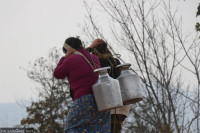Editorial
Kathmandu Valley’s water system is a gift from the past
The Valley's water spouts must be saved for their practicality as well as aesthetic value..jpg&w=900&height=601)
It is ironic that water management issues and scarcity plague the residents of the Kathmandu Valley, given that Nepal has access to plenty of snow-fed and glacier-fed water sources, and that the ancient inhabitants of the Valley had placed much focus on a functional network of water sources. For centuries, the ponds, canals and hitis of Kathmandu Valley were joined in a system that indiscriminately provided water to everyone throughout the year, all the while helping to recharge groundwater sources as well. Now, this ancient water system—still the main source of water for many—is dying out. It is a shame that this system has been underappreciated and allowed to disappear. The city governments in the Valley must prioritise its conservation. Not only are these spouts, wells and ponds part of the answer to water security issues, but they can also be cultivated as community centres with aesthetic value. After all, that is how they had been used in the past.
[Read: Kathmandu Valley’s stone spouts were once gushing with water. Now they’re slowly disappearing]
The water system of the Kathmandu Valley is considered to be one of its ‘greatest technological achievements’. Using ponds as reservoirs—fed through monsoon rains or through water canals—the system employs underground clay pipes that supply water to the hitis (water spouts). The spouts are laid out in deep pits that are below ground level, essentially using gravity to provide a steady supply of water. The walls, steps and terrace structures that make up the pit hide natural filtration, sedimentation and regulation systems that would have ensured clean running water. What is remarkable about this entire system is that until recent damage because of improper urban development, it worked as it should for centuries.
In a city that has grown to demand 360 million litres of water a day, where 20 percent of households are still not connected to the water supply, and where the authorities have only been able to ensure a maximum supply of 140 million litres a day, such an ancient utility should have been celebrated as a blessing. Instead, short-sighted development has ensured the destruction of many aspects of the system. The ponds that feed the spouts, store monsoon water and recharge aquifers have been left to stagnate or have been actively destroyed. The most famous one, Rani Pokhari, was drained by Kathmandu Metropolitan City without consulting conservation experts. Another one was destroyed last year to make way for the Chhaya Centre—a mall. The water canals and underground pipes too have been cut off or bottlenecked due to construction projects. In some cases, like Bhotahiti, the entire hiti has been covered over to facilitate the construction of buildings and underpasses.
Such myopic moves will only come back to haunt the Valley’s residents in the future. With the Melamchi water project nowhere near completion, people are already reeling under water insecurity. As such, people have had to rely on groundwater extraction, which brings with it short-term problems of iron and arsenic toxicity and long-term issues of water shortage and entire geographic areas becoming unstable and sinking. Bhaktapur and Lalitpur have started to conserve their ponds, which is a step in the right direction. However, all city governments in the Valley need to come together with a plan to conserve and restore the entire water system.
***
What do you think?
Dear reader, we’d like to hear from you. We regularly publish letters to the editor on contemporary issues or direct responses to something the Post has recently published. Please send your letters to [email protected] with "Letter to the Editor" in the subject line. Please include your name, location, and a contact address so one of our editors can reach out to you.




 8.12°C Kathmandu
8.12°C Kathmandu














